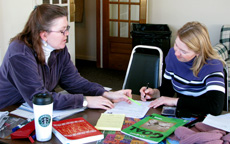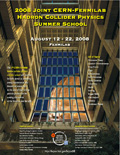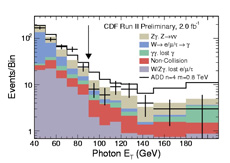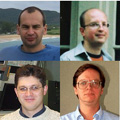|
Thursday, Feb. 14
Noon
Special Particle Astrophysics Seminar - Dark Side, WH-6NW (NOTE DATE, TIME, LOCATION)
Speaker: A. Mazumdar, Nordic Institute for Theoretical Physics
Title: Detecting Inflation and Dark Matter at the LHC
THERE WILL BE NO PHYSICS AND DETECTOR SEMINAR THIS WEEK
2:30 p.m.
Theoretical Physics Seminar - Curia II
Speaker: J. Winter, Fermilab
Title: The Sherpa Approach to Calculating Multijet Backgrounds
3:30 p.m.
DIRECTOR'S COFFEE BREAK - 2nd Flr X-Over
THERE WILL BE NO ACCELERATOR PHYSICS AND TECHNOLOGY SEMINAR TODAY
Friday, Feb. 15
3:30 p.m.
DIRECTOR'S COFFEE BREAK - 2nd Flr X-Over
4 p.m.
Joint Experimental-Theoretical Physics Seminar - One West
Speaker: M. Voutilainen, University of Nebraska, Lincoln
Title: Inclusive Jet Production at DZero
Click here for NALCAL,
a weekly calendar with links to additional information.
|
Thursday, Feb. 14
- Tomato Florentine
- *Grilled chicken cordon bleu sandwich
- Chimichangas
- Smart cuisine
- Smoked turkey melt
- Assorted slice pizza
- SW chicken salad w/roasted corn salsa
Wilson Hall Cafe menu |
|
Thursday, Feb. 14
Dinner
- Red pepper soup
- Steamed lobster tails w/mousseline sauce
- Asparagus w/lemon rind
- Sweetheart salad (beets, walnuts & bleu cheese)
- Lover's delight
Wednesday, Feb. 20
Lunch
- Spicy meat turnovers
- Confetti salad
- Pineapple rum cake
Chez Leon menu
Call x4598 to make your reservation. |
|
|
Volunteer teaches English language survival

Kim Habig teaches survival English to Lena Singatulina, the spouse of Russian scientist Shavkat Singatulin.
Kim Habig knows a thing or two about language. She spent 19 years teaching language, including two years in Japan teaching English and a few years teaching Japanese to native English speakers in Minnesota. So when her husband, Alec, a MINOS collaborator, took a one-year position as run-coordinator at Fermilab, she decided to put her skills to use.
She began Jan. 30 teaching English as a Second Language class weekly at the Fermilab Users' center.
Other laboratory employees' spouses who were attending intermediate ESL classes suggested that she start a beginner class onsite.
"They thought it might be useful for the moms, women or non-working spouses whose language skills are limited," Habig said.
Although so far Habig has only had a handful of attendees to her class, she hopes that others will take advantage of the free service soon.
On Wednesday, Habig instructed Lena Singatulina, wife of Fermilab scientist Shavkat Singatulin in how to recognize and answer basic social questions, such as "When did you come to this country?" and "How many children do you have?" Singatulina and her husband came to this country about a year ago.
Unlike traditional language classes, Habig's focuses less on grammar and more on need-based language such as how to describe an illness to a nurse.
"My class targets the beginner. The people who need help in everyday situations, such as grocery shopping. It's survival English," Habig said.
The class runs each Wednesday from 10-11:30 a.m. through May 14. Newcomers can come anytime. Anyone interested can contact Kim Habig via e-mail or at x4240.
-- Rhianna Wisniewski
|
HC Physics summer school for Generation LHC
 |
| CERN-Fermilab Hadron Collider Physics Summer School registration is open until Feb. 29. |
When students emerge from the CERN-Fermilab Hadron Collider Physics Summer School later this year, organizers hope they'll be better positioned to make discoveries.
"We're preparing them to better analyze and interpret data at the Tevatron and the LHC," said school co-director and Fermilab physicist Harry Cheung. "So far, they probably have had limited exposure, so this is a chance for them to see what else is out there that may interest them."
The third session of the summer school, held at Fermilab Aug. 12-22, will focus on exposing young post-docs and advanced graduate students to broader theories and real data beyond what they've learned at their home institutions.
Experts from across the globe will lecture on the theoretical and experimental foundations of hadron collider physics, host parallel discussion sessions and answer students' questions. This year's school will also have a greater focus on physics beyond the Standard Model, as well as more time for questions at the end of each lecture.
"We really want to emphasize student participation," said school co-director and Fermilab theorist Marcela Carena.
Students attending the nine-day school will learn about the latest theoretical ideas as well as experimental techniques from the Tevatron experiments, something that Carena believes is crucial to prepare the next generation of researchers.
"I hope that the students get a great foundation," Carena said. "The school is very special because of the current situation. It is an amazing time with the startup of the LHC, and with great data from the current Tevatron run, which can lead to discoveries, or exciting expectations for the LHC."
Applications from both theorists and experimentalists interested in Hadron Collider physics will be accepted until Feb. 29. Visit the HCP Summer School Web site to apply or for more information.
-- Rhianna Wisniewski
|
Budget cuts undermine U.S. role in atom-smasher project
From Wired.com,
Feb. 13, 2008
Physicists have developed a plan to keep a $6.6 billion international particle accelerator project moving forward, despite deep budget cuts that have all but stopped participation by American and British scientists this year.
However, those funding cuts have made it less likely that the groundbreaking project will wind up on U.S. soil, participants say. American researchers, fearful of losing their traditional leadership in the field, had hoped to bring the proposed facility to the United States.
Read more
|
|
|
Shedding light onto
other dimensions

Photon transverse momentum comparing the data to the predictions. The data is unfortunately compatible with the expected background. If there were extra dimensions, the distributions might look more like the black line.
Do we live in a three-dimensional world, or is nature more complex than that? If there are more dimensions, can matter move between them?
It sounds like science fiction, but well-established theoretical physics models predict that. One of them, a model of large extra dimensions predicts that the world we live in is part of a space of additional dimensions. The additional spatial dimensions wrap around themselves on a scale as large as millimeters. In a fewer-dimensional analogy, a tightrope would appear in a line when seen from far away, but is actually is a tightly coiled cylinder.
While gravity can move anywhere in these dimensions, everything else is confined to our 3D world. In collisions at the Tevatron, it might be possible to excite gravity waves from other dimensions. These waves would appear as invisible massive particles. If produced along with a photon, these would produce a unique signature: a single photon with nothing to balance it out. In the Standard Model, only one process has such a signature: The production of a photon with a Z0 boson that decays to two neutrinos. After applying selection criteria to remove cosmic events, this process has produced only about 80 events at CDF out of the Tevatron's roughly 100 trillion collisions so far.
Alas, the number of single-photon events observed by CDF physicists is consistent with the expectations from known processes; no excess is observed. It could be that the extra dimensions are too small to be seen with this particular search. More collision events and further hard work will hopefully allow CDF physicists to shed the light on this existential dimensional question.
 |
Top: Max Goncharov, Texas A&M; Vyacheslav Krutelyov, UC Santa Barbara. Bottom: Alexandre Pronko, Fermilab; and Raymond Culbertson, Fermilab. |
Result of the Week Archive
|
|

From Physical Review D personal ads:
Mature paradigm with firm
observational support seeks a
fundamental theory in which to
be embedded. No loop
quantum gravity theories,
please. Contact alan@mit.edu.
Elegant theory of everything
desires to explore the
landscape with a phenomenon
in the hope that it will lead to a
prediction. Let's get physical!
Contact ed@ias.edu.
|
|
Have a safe day!
Housing assignments for summer 2008
The Fermilab Housing Office accepts requests for houses, apartments and dormitory rooms for summer 2008. Please submit requests for reservations by Monday, March 3, because Housing expects more requests than available facilities. Requests can be made for any period and need not commence on any particular date. For further information, please contact the Housing Office at (630) 840-3777.
Individuals can make housing requests using our Online Housing Request form.
Requests for multiple housing units are handled by direct e-mail to housing@fnal.gov.
Employee art show - applications due 2/25
"Hidden Talents: Fermilab Employee Art Show" will be on display, March 19 - May 14, 2008. Intent applications are due Feb. 25 and forms are available in the Art Gallery on the stand near Curia II or on the Web.
International Folk Dance Feb. 14
International Folk Dancing will meet Thursday, Feb. 14, at Kuhn Barn on the Fermilab site. Dancing begins at 7:30 p.m. with teaching and children's dances earlier in the evening and request dancing later on. Newcomers are welcome and you do not need to come with a partner. Get more information at 630-584-0825 or 630-840-8194 or folkdance@fnal.gov.
Kyuki-Do class begins Feb. 25
Kyuki-Do, a martial art similar to Taekwondo, leads to a practical method of self-defense. It teaches balance, power and grace. Classes are held for six weeks on Monday and Wednesday from 5-6 p.m. at the Recreation Facility. You must register through the Recreation Office and have a Recreation Facility membership.
Folk Club Barn Dance Sunday
Fermilab Folk Club Barn Dance Sunday, Feb. 17, at 2 p.m. with music by Gena & Smith and calling by Lynn Garren. More info
Additional Activities |
|